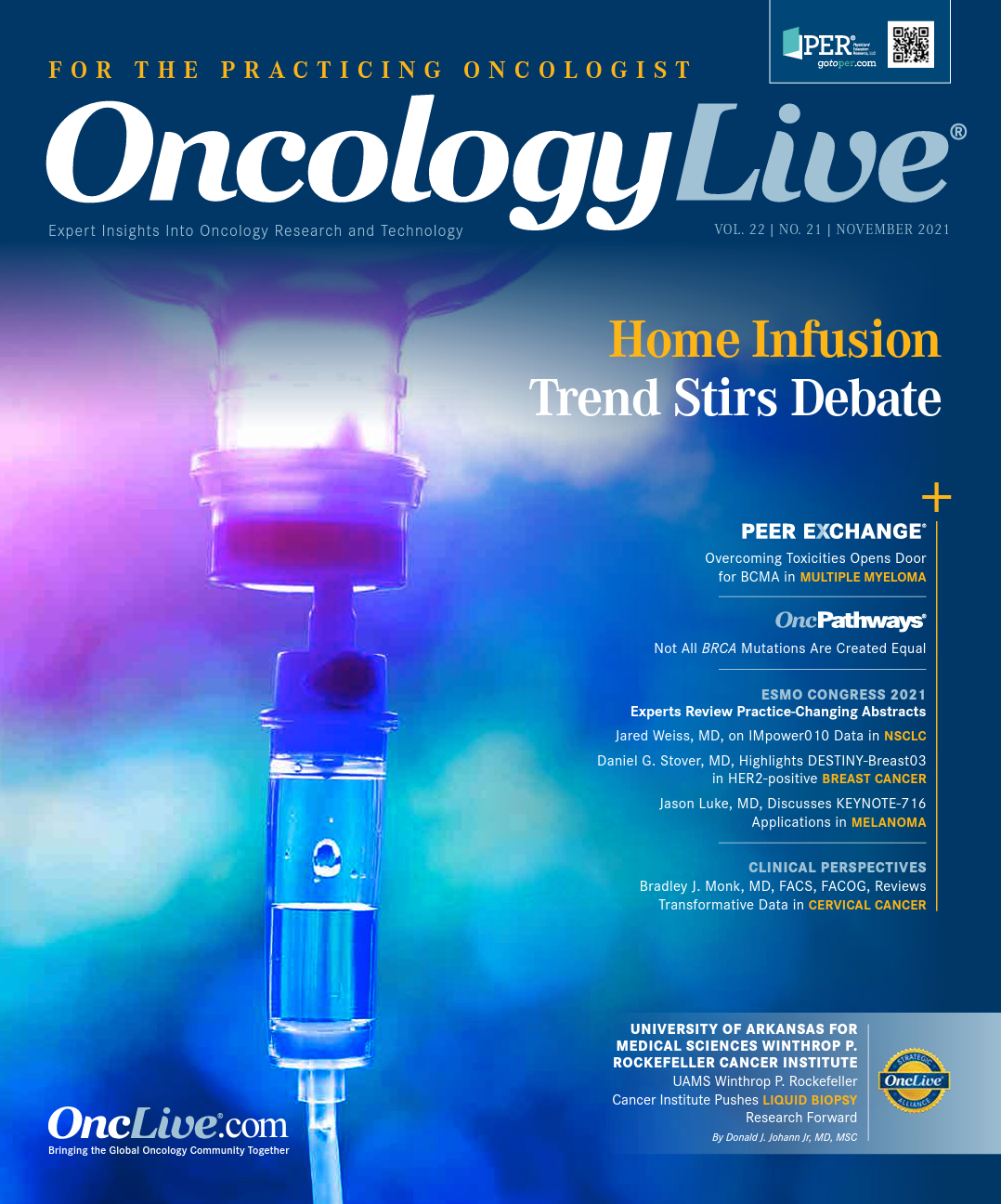Experts Review Key Data From ESMO Congress 2021
Several leading experts discussed a variety of tumor types set to influence the next wave of investigative directions and change the standard of care for patients in abstracts at the European Society for Medical Oncology Congress 2021.
Jared Weiss, MD, of University of North Carolina School of Medicine

Nearly 2,000 abstracts were included in the proceedings at the European Society for Medical Oncology (ESMO) Congress 2021. The data presented in late-breaking abstracts, at presidential symposia, and during poster sessions have contributed to the evolving treatment landscape across the continuum of care.
During the meeting, OncologyLive® spoke with several leading experts on a variety of tumor types, each of whom highlighted those abstracts set to influence the next wave of investigative directions and change the standard of care for patients.
Lung Cancer
Jared Weiss, MD, Associate Professor of Medicine, Section Chief of Thoracic and Head/Neck Oncology, Research POD Leader for Thoracic Oncology, and Associate Director for Finance of the Clinical Protocol Office University of North Carolina School of Medicine, Chapel Hill, NC
LBA9 IMpower010: Sites of relapse and subsequent therapy from a phase III study of atezolizumab vs best supportive care after adjuvant chemotherapy in stage IB-IIIA NSCLC
In the phase 3 IMpower010 trial (NCT02486718), 1005 patients with completely resected stage IB to IIIA non–small cell lung cancer NSCLC were randomized 1:1 to receive either 1200 mg of atezolizumab (Tecentriq) every 21 days or best supportive care following 1 to 4 cycles of cisplatin plus pemetrexed, gemcitabine, docetaxel, or vinorelbine. Atezolizumab extended the disease-free survival benefit in patients in the all-randomized stage II to IIIA population with PD-L1 expression on at least 50% of tumor cells (TC; HR, 0.43; 95% CI, 0.27-0.68).
In findings from a subgroup analysis, adjuvant treatment with atezolizumab provided a modest disease-free survival benefit for patients with TC 1% to 49% (HR, 0.87; 95% CI, 0.60-1.26) in all-comers including those with EGFR or ALK mutations. These results confirmed that the benefit observed in the TC 1% or higher population (HR, 0.66; 95% CI, 0.50-0.88) was primarily driven by those with TC 50%. Based on these data, atezolizumab was approved for the adjuvant treatment of patients with PD-L1 expression on at least 1% of tumor cells in October.
“One abstract of particular [interest] for me [concerned] the [IMpower010] data. We had previously seen [results of this] study, but one thing that was really missing was the subgroup analysis by PD-L1 [expression]. It was clear, prior to ESMO, that patients with stage II and III disease and PD-L1 of at least 50% would benefit. [However, the] analysis was of the 1% [or greater population] not 1% to 49%, leaving open the question of whether the benefit in the 1% [or greater] population was entirely driven by those who were 50% or greater or whether the patients with 1% to 49% actually derived benefit.
At ESMO 2021 I was very pleased to see this subgroup analysis. It had a trend in the right direction which for me is good enough, [because] I’ll remind everyone that [the study] wasn’t powered to address that subgroup analysis.”
LBA47: Activity of OSE-2101 in HLA-A2+ non–small cell lung cancer (NSCLC) patients after failure to immune checkpoint inhibitors (IO): Final results of phase III Atalante-1 randomised trial
The final results of the phase 3 ATALANTE 1 trial (NCT02654587) demonstrated that use of the anticancer neo-epitope–based vaccine OSE2101 (Tedopi) resulted in a statistically improved survival benefit as treatment for patients with advanced or metastatic NSCLC with secondary resistance to platinum-based chemotherapy and immunotherapy (combined or sequenced).
Specifically, the median overall survival (OS) for patients who received the vaccine (n = 80) was 11.1 months (95% CI, 8.6-13.5) compared with 7.5 months (95% CI, 4.7-10.3) for those who received standard of care (n = 38; HR, 0.59; 95% CI, 0.38-0.91; P = .017). Of patients who experienced disease progression, those who received OSE2101 had a greater delay in the time of progression to death compared with standard of care. The median postprogression OS was 7.7 months (95% CI, 5.6-9.7) in the experimental arm vs 4.6 months (95% CI, 3.1-5.8) in the control arm (HR, 0.46; 95% CI, 0.27-0.79; P = .004).
Based on these data, investigators concluded that the benefit to risk ratio was favorable for OSE2101 for this patient population who do not have therapeutic alternatives.
“There were a lot of abstracts that are of relevance to research even if they are not reaching clinical practice. One that is not being discussed as much, but that I found interesting, [concerns the one with data on] OSE2101, a [human leukocyte antigen] vaccine targeting 5 tumor associated anti-gens, compared with docetaxel.
I don’t know if [these data will] result in approved use, but for those interested in personalized immunotherapy I think it gives [one] heart that a vaccine approach done right could yield fruit. When you think about other approaches being taken to personalize [treatments] with advanced bioinformatics sequencing and improvements in adjuvant [treatment options] and other aspects of vaccination, I think it adds a little wind to the sails that this approach may ultimately be something that helps patients.”
Marina Chiara Garassino, MBBS, Professor of Medicine, University of Chicago Medicine, Chicago, IL
Marina Chiara Garassino, MBBS, of University of Chicago Medicine

1254P: Efficacy and safety of tepotinib in patients (pts) with advanced age: VISION subgroup analysis of pts with MET exon 14 (METex14) skipping NSCLC
Investigators observed robust and durable clinical activity in patients with non–small cell lung cancer with MET exon 14 skipping treated with tepotinib in the phase 2 VISION trial (NCT02864992). Among 275 patients who received no more than 2 lines of prior therapy, the overall response rate (ORR) was 49.1% (95% CI, 43.0%-55.2%), the median duration of response was 13.8 months (95% CI, 9.9-19.4), and the median progression-free survival was 10.8 months (95% CI, 8.5-12.4).
When stratified by age (< 75 years [n = 157] vs ≥ 75 years [n = 118]), the ORRs were 52.2% (95% CI, 44.1%-60.3%) vs 44.9% (95% CI, 35.7%-54.3%), respectively. The median duration of response was 12.4 (95% CI, 9.5-32.7) vs 13.8 months (95% CI, 9.0-not estimable), and median progression-free survival was 11.0 (95% CI, 8.2-13.7) vs 10.4 months (95% CI, 8.2-13.7). The investigators concluded that continued exploration of tepotinib and other novel targeted therapies directed against MET exon 14 skipping should be prioritized for the treatment of patients of advanced age.
“This is a very rare target, and we must be aware that the target can be present not just in adenocarcinoma but also in other histologies. It is important to also remember that [patients] can have a very long-lasting response with MET inhibitors, in this case with tepotinib. The drug is feasible [as a treatment] in older populations and clearly is much better than chemotherapy.”
Luis Paz-Ares, MD, PhD, Head of the H120-CNIO Lung Cancer Clinical Research Unit, Spanish National Cancer Research Center, Chair of the Medical Oncology Department, 12 de Octubre University Hospital, Associate Professor, Complutense University of Madrid, Madrid, Spain
Luis Paz-Ares, MD, PhD, of 12 de Octubre University Hospital

LBA61: Durvalumab ± tremelimumab + platinum-etoposide in first-line extensive-stage SCLC (ES-SCLC): 3-year overall survival update from the phase III CASPIAN study
Results from an updated analysis of the phase 3 CASPIAN trial (NCT03043872) showed that the addition of durvalumab (Imfinzi) to platinum-etoposide maintained a significant survival benefit in patients with extensive-stage small cell lung cancer (ES-SCLC) vs platinum-etoposide alone. At the 3-year follow-up the median overall survival (OS) was 12.9 months (95% CI, 11.3-14.7) vs 10.5 months (95% CI, 9.3-11.2), respectively (HR, 0.71; 95% CI, 0.60-0.86; P = .0003). The 3-year OS rates were 17.6% vs 5.8%, respectively.
The investigators noted that with 3 times more patients estimated to be alive at 3 years when treated with the anti–PD-L1 chemotherapy combination, the regimen should be considered the first-line standard of care for patients with ES-SCLC.
“I want to emphasize the fact that trials, in particular immunotherapy trials, should be followed up long term. I understand that hazard ratio is very important, median survival is very important, and [these are end points] that lung cancer physicians are used to. But here we have a new dimension, which is the long-term benefit [and] the potential for cure. This trial and others are opening the door to something that we didn’t ask or talk about in the past with our patients.”
Gastrointestinal Cancer
Daniel Catenacci, MD, Associate Professor of Medicine, Director of the Gastrointestinal Oncology Program, University of Chicago Medicine, Assistant Director of Translational Research, University of Chicago Medicine Comprehensive Cancer Center, Chicago, IL
Daniel Catenacci, MD, of University of Chicago Medicine

LBA6 KRYSTAL-1: Adagrasib (MRTX849) as monotherapy or combined with cetuximab (Cetux) in patients (Pts) with colorectal cancer (CRC) harboring a KRAS G12C mutation
Investigators in the phase 1/2 KRYSTAL-1 trial (NCT03785249) assessed the efficacy of the novel KRAS G12C inhibitor adagrasib in patients with solid tumors harboring the mutation. The efficacy results for those with colorectal cancer showed that the agent elicited a 22% response rate among patients treated with the agent as a monotherapy, including 1 unconfirmed partial response. Further, 64% of patients had stable disease and investigators observed clinical benefit in 87% of patients. The median duration of response was 4.2 months (range, 2.3-6.9) and at the data cutoff of May 25, 2021, 40% of patients remained on treatment.
In the efficacy population (n = 46) for progression-free survival (PFS) analysis the median PFS was 5.6 months (95% CI, 4.1-8.3), with a 6-month PFS rate of 42%.
For patients treated with adagrasib in combination with cetuximab (Erbitux; n = 28), the response rate was 43% including 2 unconfirmed partial responses. The investigators observed stable disease in 57% of patients and reported that clinical benefit was observed in 100% of treated patients. At data cutoff of July 9, 2021, 71% of patients remained on treatment.
“The story in colorectal cancer is [all about the] KRAS G12C mutation and there are some promising approaches. As studies mature and get larger, that is an important one.”
LBA54: Ipilimumab or FOLFOX in combination with nivolumab and trastuzumab in previously untreated HER2 positive locally advanced or metastatic esophagogastric adenocarcinoma (EGA): Results of the randomized phase II INTEGA trial (AIO STO 0217)
Investigators evaluated 2 experimental first-line treatment options in the phase 2 INTEGA trial (NCT03409848) for patients with HER2-positive advanced or metastatic esophagogastric adenocarcinoma. Patients were randomized to receive either trastuzumab (Herceptin) plus nivolumab (Opdivo) plus ipilimumab (Yervoy) or trastuzumab and nivolumab in combination with leucovorin, 5-fluorouracil, and oxaliplatin (FOLFOX). Each arm had 44 patients. The overall response rate was 56% in the FOLFOX arm compared with 32% in the immunotherapy triplet arm. The median progression-free survival was 10.7 months vs 3.2 months, respectively.
“In the HER2 space for gastroesophageal cancer there are a lot of exciting, targeted therapies coming through [that are] trying to build on chemotherapy plus trastuzumab with or without immunotherapy. I think that those strategies are also going to be promising in the future.”
Breast Cancer
Hope S. Rugo, MD, FASCO, Professor of Medicine, Director of Breast Oncology and Clinical Trials Education, University of California San Francisco Helen Diller Family Comprehensive Cancer Center, San Francisco, CA
Hope S. Rugo, MD, FASCO, of University of California San Francisco Helen Diller Family Comprehensive Cancer Center

LBA16 KEYNOTE-355: Final results from a randomized, double-blind phase III study of first-line pembrolizumab + chemotherapy vs placebo + chemotherapy for metastatic TNBC
The addition of pembrolizumab (Keytruda) to chemotherapy in the first-line setting elicited clinically meaningful improvements in overall survival (OS) and progression-free survival (PFS) for patients with PD-L1–positive (combined positive score [CPS] ≥ 10), metastatic triple-negative breast cancer (TNBC) vs placebo plus chemotherapy. The data met the primary end points of the phase 3 KEYNOTE-355 trial (NCT02819518).
Specifically, the median OS in the intention-to-treat population with pembrolizumab (n = 566) was 17.2 months vs 15.5 months with placebo (n = 281; HR, 0.89; 95% CI, 0.76-1.05). The 2-year OS rates were 35.5% vs 30.4%, respectively. The median PFS was 7.5 months in the investigative arm compared with 5.6 months in the placebo arm (HR, 0.82; 95% CI, 0.70-0.98), and 1-year PFS rates were 29.3% vs 20.8%.
When stratified by CPS, pembrolizumab demonstrated the greatest benefit in patients with CPS of 10 or greater. The median OS for patients who received pembrolizumab (n = 220) was 23.0 months vs 16.1 months for those who received placebo (n = 103; HR, 0.73; 95% CI, 0.55-0.95; one-sided P = .0093). The 2-year OS rates were 48.2% vs 34.0%, respectively. The median PFS was 9.8 months with pembrolizumab vs 5.6 months with placebo (HR, 0.66; 95% CI, 0.50-0.88), with a 1-year PFS rate of 39.1% vs 23.0%, respectively.
“It’s great to see a survival advantage. It’s interesting to me that the survival difference was similar to what was shown in IMpassion130 [NCT02425891]; however, IMpassion130 had a different statistical design, which was hierarchical, and because they didn’t show a survival benefit in the intention-to-treat population, [investigators] weren’t allowed to assess formal statistical differences in the PD-L1–positive population…. So it brings up the question: If you had a patient who was [PD-L1] positive via SP142 [Ventana PD-L1 assay], what would you do?
Because of the] unfortunate design and negative results from IMpassion131 [NCT03125902], Roche withdrew the [indication for atezolizumab (Tecentriq) in the United States] because they did not have confirmatory data. Right now, I would treat these [US patients] with pembrolizumab because I think those patients would benefit.
I do think this is a new standard of care. It’s critical that patients, staff, and physicians be educated about how to recognize immune-related toxicities as early as possible and institute treatment that I think really makes a big difference. It is important to keep in mind that we are only benefitting 40% of our patients, so we need more treatments and [we need to] encourage enrollment in clinical trials that are looking at combination therapies and novel agents to improve outcomes for patients with TNBC.”
Daniel G. Stover, MD, Assistant Professor of Medicine, The Ohio State University College of Medicine, Columbus, OH
Daniel G. Stover, MD, of The Ohio State University College of Medicine

LBA1: Trastuzumab deruxtecan (T-DXd) vs trastuzumab emtansine (T-DM1) in patients (pts) with HER2+ metastatic breast cancer (mBC): results of the randomized phase 3 DESTINY-Breast03 study
One of the highly anticipated studies presented at ESMO 2021 was the late-breaking abstract highlighting data from the Destiny-Breast03 trial (NCT03529110), the first head-to-head study of fam-trastuzumab deruxtecan-nxki (Enhertu) vs ado-trastuzumab emtansine (T-DM1; Kadcyla) for patients with advanced HER2-positive metastatic breast cancer previously treated with trastuzumab (Herceptin) and taxane.
Results showed that the median progression-free survival (PFS) for patients treated with trastuzumab deruxtecan was not reached (95% CI, 18.5-not estimable [NE]) vs 6.8 months (95% CI, 5.6-8.2) with T-DM1 (HR, 0.28; 95% CI, 0.22-0.37; P = 7.8 × 10-22). Among the 261 patients in the trastuzumab deruxtecan arm the 12-month PFS rate was 75.8% (95% CI, 69.8%-80.7%) vs 34.1% (95% CI, 27.7%-40.5%) among 263 patients treated in the T-DM1 arm. In a discussion of the data during the meeting, investigator Shanu Modi, MD, said, “If the waterfall plot from DESTINY-Breast01 [NCT03248492] was dramatic, I think these PFS curves from DESTINY-Breast03 are startling.”
Further, the median overall survival (OS) was NE in both arms (HR, 0.56; 95% CI, 0.36-0.86; P = .007172). The 12-month OS rates were 94.1% (95% CI, 90.3%-96.4%) in the trastuzumab deruxtecan arm vs 85.9% (95% CI, 80.9%-89.7%), in the T-DM1 arm.
“DESTINY-Breast03 reflects impressive activity of trastuzumab deruxtecan as second-line therapy for HER2-positive metastatic breast cancer, relative to current standard of care T-DM1. With higher rates of interstitial lung disease and established efficacy of trastuzumab deruxtecan after T-DM1 based on DESTINY-Breast01, it remains to be seen which patients benefit from trastuzumab deruxtecan in the second line vs later.”
Gynecologic Cancer
David M. O’Malley, MD, Professor in the Department of Obstetrics and Gynecology, The Ohio State University College of Medicine, Director of the Division of Gynecologic Oncology, Ohio State University Comprehensive Cancer Center – Arthur G. James Cancer Hospital and Richard J. Solove Research Institute, Columbus, OH
David M. O’Malley, MD, of The Ohio State University College of Medicine

LBA33: Maintenance olaparib rechallenge in patients (pts) with ovarian carcinoma (OC) previously treated with a PARP inhibitor (PARPi): Phase IIIb OReO/ENGOT Ov-38 trial
In the double-blind, phase 3 OReO study (NCT03106987), patients with nonmucinous platinum-sensitive relapsed ovarian cancer were retreated with the PARP inhibitor olaparib (Lynparza) 300 mg or placebo until disease progression. Results showed that rechallenge with maintenance olaparib following disease progression with a PARP inhibitor and a complete or partial radiological response to subsequent treatment with platinum-based chemotherapy improved progression-free survival (PFS) vs placebo regardless of BRCA mutation status.
For patients with BRCA-mutant disease the median PFS was 4.3 months for those who received olaparib (n = 74) vs 2.8 months with placebo (n = 38; HR, 0.57; 95% CI, 0.370.87; P = .022). The 12-month PFS rate in this patient population was 19% vs 0%, respectively. In the cohort of patients without BRCA mutations, the median PFS for those who received olaparib (n = 72) was 5.3 months vs 2.8 months with placebo (n = 36; HR, 0.43; 95% CI, 0.26-0.71; P = .0023). The 12-month PFS rates were 14% vs 0%, respectively.
“[Data from the] OReO trial showed the benefit of PARP inhibitors in platinum-sensitive recurrence in the maintenance setting. These improvements were modest, however [results] did show that one of the best predictors of PARP responsiveness is the responsiveness to platinum.
We need a lot more information from this trial...as very small numbers of responsiveness may be driving the overall hazard ratio. For example, what wasn’t presented was the number of patients who had discontinued prior PARP exposure because of toxicity vs [those who discontinued because of] progression or they completed therapy; in other words, 2 years with the SOLO-1 [regimen (NCT01844986)] or 3 years with the PRIMA [regimen (NCT02655016)]. The patient [who does not experience] progression on PARP vs the patient who progresses seem to be much different patient populations and we need to get more information.”
Melanoma
Jason Luke, MD, Associate Professor of Medicine, Division of Hematology/Oncology, Director of the Cancer Immunotherapeutics Center, University of Pittsburgh Medical Center Hillman Cancer Center, Cancer Immunology and Immunotherapy Program, Pittsburgh, PA
Jason Luke, MD, of University of Pittsburgh Medical Center Hillman Cancer Center

LBA3_PR: Pembrolizumab versus placebo after complete resection of high-risk stage II melanoma: Efficacy and safety results from the KEYNOTE-716 double-blind phase III trial
Patients with high-risk stage II melanoma saw a significant reduction in the risk of disease recurrence or death when treated with adjuvant pembrolizumab compared with placebo, according to results of the phase 3 KEYNOTE-716 trial (NCT03553836). Median recurrence-free survival (RFS) was not reached in either arm (HR, 0.65; 95% CI, 0.46-0.92; P = .00658). The 12-month RFS rate was 90.5% among 487 patients who received adjuvant pembrolizumab vs 83.1% for the 489 patients who received placebo.
“KEYNOTE-716 is very early in its [data] maturation and there are a lot of patients who haven’t had recurrence events. Despite having quite a substantial benefit that will likely change practice in terms of RFS, we expect that the benefit will increase over time. We are seeing a 35% benefit in terms of reducing recurrence [and] I fully expect that number is going to go up over time as more events happen in the clinical trial.
Another really important aspect of this trial is that it has 2 parts: the first part is the adjuvant treatment, and the second part is the crossover. Following patients and seeing what happens to them after they have recurrence events and go on to other therapies is an absolutely essential part of this clinical trial. [This way] we can better understand the long-term implications of these clinical data and what happens to these patients in these scenarios because we haven’t had this before.
There were some naysayers when we started this trial [who said] that [patients with] stage IIB and IIC disease were too low risk to treat in a clinical trial. I think these results really emphasize that patients with those disease stages truly are at high risk for rapid and distant metastatic recurrence. Treatment with pembrolizumab improves that situation quite substantially. I think this treatment should be offered to all patients with stage IIB and IIC and we should stop thinking about nonmodal melanoma as low risk; in fact, it is high risk and these patients deserve the opportunity to be treated.”




